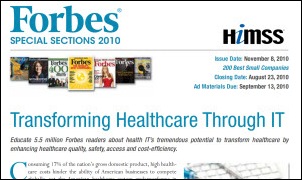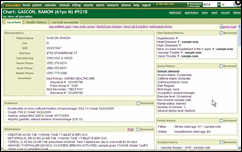The UHC hiding the breach notice page is one thing but it looks like Nebraska is suing Change Healthcare for…
News 8/20/10
From Scatman Crothers: “Re: Stanford Hospital and Clinics. Replacing Dell Perot, which has just a few months to transition and leave. Accenture is taking over the whole thing.” Unverified. Perot got that seven-year deal in 2004, so maybe Accenture won the next round.
From No Surprise Here: “Re: EMRs. A study of California hospitals shows minimal positive effects of EMRs.” I hesitate to comment because the article is not up in full text yet, but it concludes: “EMR implementation was associated with 6-10 percent higher cost per discharge in medical-surgical acute units. EMR stage 2 increased registered nurse hours per patient day by 15-26 percent and reduced licensed vocational nurse cost per hour by 2-4 percent. EMR stage 3 was associated with 3-4 percent lower rates of in-hospital mortality for conditions.” I’ll be interested to see whether the authors attempted to quantify before and after results from individual hospitals, and if so, how they handled the other variables that surely changed in the study’s nine-year timeframe. My experience with these database-driven analyses, usually conducted by publish-or-perish academics, is that they use public information that’s conveniently available but not terribly relevant, leaving logic holes you could drive a truck through. I’ll review the article once it’s out.
From Jennifer: “Re: CPOE and meaningful use. My hospital uses protocol orders for meds that are triggered by specific criteria. For example, a lady comes in with a troponin of 1.0, which orders a contraindication screening for the nurse to complete. If no contraindications exist, then aspirin and Toprol are automatically ordered. These orders go to the queue for the attending physician to sign and are driven by evidence-based practice, but aren’t considered written, verbal, or direct. How would these be defined under Meaningful Use?” I’ll say upfront that I have no idea and I doubt HHS does either, but it seems reasonable to count them as physician-entered (feel free to correct me if you know for sure). The physician has agreed to use of the protocol and is the first signer of the order, so that sounds like a CPOE order to me and it’s certainly not a paper order. I’ll also add that one of the seldom-discussed aspects of MU is that it resembles Most Wired in that you turn in your own numbers with minimal chance of being audited, so in the absence of definitive guidance, I’d count those orders. Not to mention that evidence-based order sets like this are exactly what the government should be encouraging.
From HIT Insider: “Re: Eclipsys. Another sales leader departs – Jay Colfer, SVP who managed the biggest revenue producing team in the company. Big loss.” Unverified, but not surprising if true. If you’re a sales stud, you can work anywhere without the uncertainty of an impending acquisition on prospects and your own career possibilities. I wouldn’t say it’s a negative development for either the company or the individual.
Listening: new Iron Maiden, slower and more complex than their frenetic 80s stuff, lapsing more into non-wimpy progressive (think Ritchie Blackmore’s Rainbow or Rush with some AC/DC admixed in). I never liked them much, but this is really good. It’s a long album, but I’m on my third listen and liking it better each time. Based on this live video, I’d definitely go see them.
Weird News Andy warns ahead of time that this story might offend some sensibilities, so I shall word it carefully. A newly delivered mother in China claims that her midwife, unhappy with the insufficient tip given to her by the father, sutures shut a nearby but unrelated opening. Also from WNA: a quality analysis concludes that church-owned hospitals deliver better quality care than for-profit ones, with Catholic hospitals also outperforming community hospitals.
HIMSS is involved, for some reason, with a November advertising insert in Forbes called Transforming Healthcare Through IT. The pitch: “Produced in partnership with the Healthcare Information and Management Systems Society (HIMSS), Forbes’ special Health IT report offers participating advertisers the opportunity to share how your organization will contribute to healthcare transformation through IT.” Whatever happened to just doing it instead of preening in front of a business reader audience? I’d bet that the only companies that sign up are those that are publicly traded or those that yearn to be.
Thanks to AdvancedMD for supporting both HIStalk and HIStalk Practice at the Platinum level. The Draper, UT-based company offers a Web-based practice EHR, practice management, medical billing, scheduling, and e-prescribing. The company also offers its AdvancedBiller program, which connects billing service partners with practices. As often happens, our first contact with the company was when Inga interviewed CEO Eric Morgan a couple of weeks ago, apparently triggering the company’s interest in supporting what we do. It’s a good interview — Eric and Inga covered the pros and cons of being a privately held company, EHR market consolidation, how AdvancedBiller competes with companies like athenahealth, and the influence of hospitals on practice EHR adoption. Thanks to AdvancedMD for supporting HIStalk and its readers.
University of Chicago Medical Center partners with a technology company to produce an epilepsy monitoring system that uses Bluetooth and a smart phone to continuously stream EEG information to a monitoring center. Interesting: it won’t work in iPhones because Apple hasn’t opened up the APIs it needs. Also interesting: the company has patented a technology that uses text messages to trigger smart phone events, which I assume means that monitoring centers could “order” additional diagnostics remotely by cell phone.
Industry longtimer J. R. Hughes, most recently at McKesson, joins the nine-employee healthcare consulting firm The Winkenwerder Company, which has some impressive clients.
Patient Privacy Rights releases its Health Privacy Risk Calculator, which is really kind of pointless since just about every American will score in the High Risk red zone (it only takes three positive answers to questions such as do you have insurance, do you take prescription meds, and do you pay for any health-related products using checks or credit cards). Actually, I guess that was the point.
Holzer Consolidated Health System (OH) chooses help desk and performance monitoring services from CareTech Solutions.
I’ve joked that the VA and DoD should get rid of their expensive, contractor-managed systems and just buy Epic even though I’m not sure it could cleanly replace VistA or AHLTA. I recently mentioned the NextGov-generated nugget that the DoD is soliciting proposals for an AHLTA replacement. If that happens, there’s no way it will be any vendor except Epic, even though Cerner got its foot in the VA’s door by selling them Millennium lab (or nearly so — I’m not clear on whether a deal was ever signed). Epic’s the only company with experience with decentralized organizations of that size (Kaiser), not to mention that Epic’s nearly clean-sweeping the big hospital market. Benefits to DoD: it’s ready to implement instead of taking years of expensive AHLTA rewrites, it won’t choke like some of the bad software that the trough-lappers have written for the government, it will be a heck of a lot cheaper, and lots of clinicians will already know how to use it. Disadvantages: Epic’s “our way only” model won’t fly too well with the military brass, it will be missing quite a few key pieces that are unique to DoD, and there would be quite a culture clash between the Woodstock-like bunch from Wisconsin and the inside-the-beltway crew cuts.
Sponsor jobs: Web Developer, Regional VP, Project Manager/Web. On Healthcare IT Jobs: Sales Client Executive (New England), Health IT Sales, Director of Ancillary Systems, Senior Director, Applied Clinical Informatics.
I mentioned the Emendo CapPlan capacity planning software back in May. The New Zealand company wins a six-hospital deal in Canada and says it’s still planning to go after the US market.
Philips invests in a $250 million medical technology venture capital fund that will focus on home health, sleep improvement, image-guided therapies, and clinical decision support.
Rhode Island Congressman Jim Langevin visits fast-growing EHR vendor Amazing Charts, with the company’s presentation including such items as forced EHR adoption, overpriced EHRs, and the need for transparency of Regional Extension Centers (the company’s obviously got a bit of a ‘tude, which I like).
McKesson CEO John Hammergren was one of the HP board members who forced Mark Hurd out. Wonder if he’s a candidate to replace him?
Former TeleTracking sales VP Joseph Gentile joins another Pittsburgh company, healthcare robot vendor Aethon, in the same role.
MidSouth eHealth Alliance signs for the CareAlign HIE solution from Informatics Corporation of America (still my favorite company name).
Testing the North Carolina Healthcare Exchange: WakeMed and Moses Cone Health System.
Israel-based satellite services vendor Gilat Satellite, which wrote off its $4.5 million investment in Axolotl almost immediately after it made it 10 years ago, will get $24 million in cash from the proceeds of Axolotol’s sale to Ingenix, with the possibility of getting another $3 million per the contract terms.
I’m trying to strike at least a sham of work-life balance lately, so naturally I’ve fallen a bit behind as a result. I promise you’ll like me better if you indulge me by patiently awaiting any delayed e-mail replies.
HERtalk by Inga
athenaHealth announces a standalone option for its athenaClinicals product. Clients had been required to use it with athenaCollector. Removing the billing and PM service requirement will likely help athenahealth get into more opportunities, especially those involving hospitals and their affiliated physicians. Pricing is expected to be a flat fee per provider per month, based on patient volume.
The Homeland Security Department plans to acquire an EHR to manage illegal aliens detained by immigration officials. DHS says the EHR could be a commercial, government-developed, or hosted service.
Over half a million Mississippi Medicaid beneficiaries can now use Shared Health’s HIE, whose contract with Mississippi Medicaid includes the implementation of an EHR and e-prescribing system for state Medicaid providers.
Now this could be fun. Jonathan Bush from athenahealth Girish Navani of eClinical Works square off to discuss their views on the future of HIT and how each is dealing with their larger rivals. It’s September 29th in Boston.
CMS names Ingenious Med an official 2010 PQRI Registry.
St. Edward Mercy Medical Center (AR) is scheduled to go live September 26th on Epic. The local paper shares some of the detail on training requirements for users: physicians 12-16 hours, nurses and LPNs 24 to 27 hours, CNAs 6 hours, and schedulers 4-28 hours. Physicians with the hospital’s cross-town rivals are also preparing for an EHR live. By the end of the month, Sparks Health System should have several practices operational on NextGen’s EHR.
From the latest HIStalk Practice: Good Neighbor Community Health Center (NE) selects Sage Intergy CHC; the AAFP’s Center for Health raises some concerns about Meaningful Use; and, compensation for doctors in hospital-owned groups now exceeds pay for those in other type practices.
St. Charles Health System (OR) selects Velocity Technology Solutions to host and manage its Lawson ERP and Kronos time and labor management applications.
Cumberland Consulting Group promotes Amanda Hage to principal.
Members of West Virginia’s Governor’s Office of Health Enhancement and Lifestyle Planning discuss the hurdles of adopting HIT and agree that EHR utilization is a problem. Stephen Sebert, MD, the council chair for the West Virginia Medical Association, provided this comment: “I have an electronic system already, but the thing is it’s not being used.” Don’t you know his EHR vendor is cringing a bit.
Rebranding: the 20-year-old Medical Transcription Industry Association changes its name to Clinical Documentation Industry Association.
The interim administrator of Coshocton County Community Hospital (OH) says the hospital will begin a six-month installation of a new Meditech system in April. Financing for the $4 million project may be an issue: as of July, the hospital had a $3.5 million operating loss. The administrator says funds for the $246K software down payment are available from reserve funds and financing options for the rest of the project “will be researched” between now and April. The hospital hopes the system will eventually qualify them for $4.5 million worth of stimulus dollars. I wonder how many dozens (hundreds) of community hospitals around the country share similarly dismal financial pictures? Meditech, by the way, was chosen over two other vendors for “functionality, cost, and meeting government mandates.”
GetWellNetwork introduces a new interactive care solution designed for senior patients.
Orlando Health (FL) and Advocate Good Shepherd (IL) contract with PerfectServe for its clinical communications system. In addition, Hoag Hospital (CA) signs an agreement to expand its PerfectServe services to its new Irvine facility, scheduled to open later this year.













Re: California study. It won’t be long until Suzy and her creatively-named alt, “not tired of suzy,” announce that this study proves widespread industry malfeasance and is a clear call for the feds to step in. They will probably declare all of this even without reading the study.
Can’t wait to actually read the study, though. The devil’s in the details, but hopefully we’ll be able to glean ideas for improvement. It sounds like they may be differentiating between simple uses (read-only labs) and more advanced uses (CPOE, clinician notes), which could make this more useful than a blanket study.
Re: Dr Stephen Sebert (http://www.healthgrades.com/directory_search/physician/profiles/dr-md-reports/dr-stephen-sebert-md-85d21fce) at HIMG. EHR is Intergy (http://www.aiim.org/healthcare/infonomics/conversion-to-electronic-health-records.aspx)
According to the third recent study (see No Surprise Here) not sponsored by the HIT industry, IT is NOT transforming healthcare. Well, actually it is, in a way.
It is making it more costly, increasing complications, and in other studies and reports, causing adverse events, new errors, and delays in care.
I agree utterly, completely, thoroughly with Mr. Histalk, “whatever happened to just doing it…?” I wonder if it can be done if the industry continues to avoid transparency. The glitches, errors, defects, flaws, adverse events must be subject to regulatory review. The taxpayers have a right to know yhow their money is being wasted.
Suzy is right computers are bad. Just look how much time she spends ranting and raving about thier evils instead of helping her patients. That is your point right? People don’t focus enough on the patients they end up focusing on other things. I bet even right now she is focusing on what evils EMR do instead of focusing on drawing blood from some poor soul.
Just saw Iron Maiden in DC in July. Well worth it.
Chicago is ingenious with its EEG set up. Think of all of the problems that can occur, especially, misidentifcation or incorrect tests. I would hope that they are considering this as experiment with IRB approval and patient consent, an that they publish their results.
Mr. HIStalk, is this the same hospital system from which you published an email from the radiology department warning the employees that the CPOE was changing CT scan orders to “with contrast” from “no contrast”?